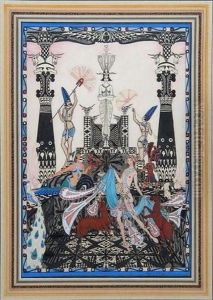Robin D' Erlanger Paintings
Roderick 'Robin' Michael Francis D'Erlanger, better known as Robin D'Erlanger, was a British painter and musician whose life spanned the late 19th and early 20th centuries. Born into an aristocratic family on June 8, 1898, he was the son of Baron Frederic Emile Baron d'Erlanger, a banker and patron of the arts, and his American-born wife, Marguerite Mathilde Slidell.
Robin's upbringing was one characterized by privilege and exposure to the cultural elite of the time. His father's passion for the arts profoundly influenced him. The d'Erlanger family had residences in both London and Paris, allowing Robin to absorb diverse artistic influences. He was educated at Eton College, an indication of his family's social status.
During World War I, Robin served in the British Army, an experience that would impact his life and work. After the war, he pursued his interest in painting, studying art in Paris. He became particularly known for his portraiture and was influenced by the post-impressionists and the symbolist movement. His works often carried a blend of realism and mysticism, a reflection of his varied interests that included music, particularly the blues.
Robin's passion for music was not merely casual; he was instrumental in promoting North African music. In 1930, he embarked on a significant project to transcribe Tunisian Malouf music, which resulted in a six-volume anthology. This work is considered an important contribution to the field of ethnomusicology and showcased his dedication to preserving cultural heritage.
In his personal life, Robin was known for his charm and charisma, which, along with his talents, made him a well-known figure in the artistic circles of his time. He was friends with several notable artists and musicians, and his home often became a gathering place for intellectuals and creatives.
Robin D'Erlanger's life was cut short when he died on October 18, 1946, at the age of 48. While he may not be as widely recognized as some of his contemporaries, his work in both the visual arts and music has left an enduring legacy that continues to be appreciated by aficionados of early 20th-century art and musicology.

